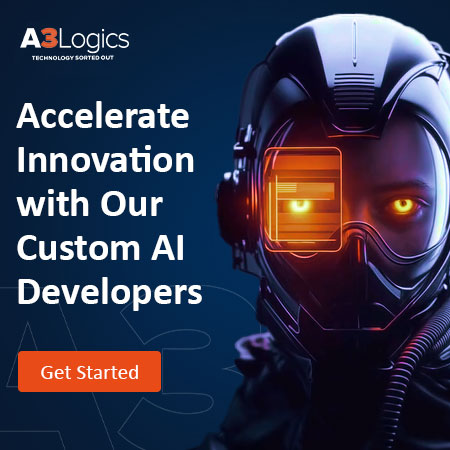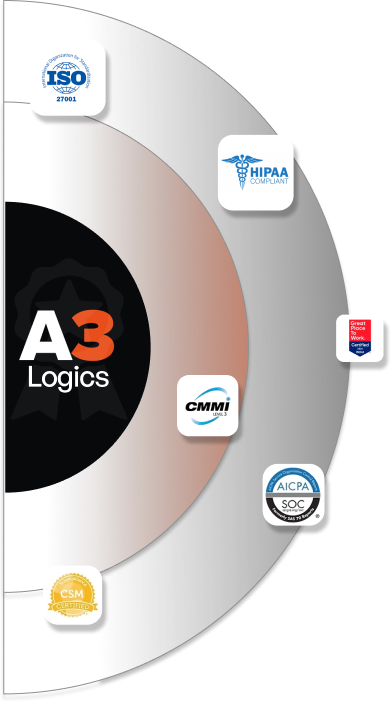The use of computer vision technology is increasing higher and that too in all industries. The best part is that it allows machines to understand, interpret and analyze data to help with the decision making. The biggest advantage of computer vision in the food industry is that it has completely automated the process of inspection, sorting and proper monitoring of the operations. So, the manual headache is reduced and it paves the way for efficient food processing operations.
All the aspects lead to the rise in demand for computer vision development services. The respective tools will come with machine learning models that will play a key role in optimizing the production workflows significantly. So, the transformation is significant with the infusion of experts of generative AI development companies that help you with computer vision applications with the right predictive analytics and deep learning frameworks.
Below, we are going to highlight all the aspects related to computer vision in the food process so that it helps you move ahead in proper decision making. Read on.
Table of Contents
Computer Vision in the Food Industry: Key Statistics
The first and most important aspect that we are going to discuss is the impact of computer vision in the food industry through numbers and stats. Computer vision’s use in the food sector has resulted in notable improvements in quality control and efficiency. These are some important figures:
- Machines currently evaluate more than 99% of video/image material recorded for corporate use; humans do not. This change draws attention to the increasing dependence on computer vision technologies for accurate jobs.
- Machine vision systems may identify tiny flaws in food goods undetectable by the human eye. This feature guarantees adherence to rigorous safety criteria and helps to minimize waste.
- By automating sorting, grading, and inspection operations, computer vision development services have helped firms to greatly lower labor expenses.
- Advanced computer vision systems can detect contamination or deterioration early, hence protecting public health and improving brand reputation.
These figures highlight the changing influence of computer vision in food processing and its part in determining the future of the sector.
Key Applications of Computer Vision in Food Processing
Below are the essential applications of the use of computer vision in the food processing industry. Check it out.
Quality Control and Inspection
Automating quality checks with remarkable accuracy depends on computer vision in food production. Real-time identification of flaws such as discoloration, uneven forms, or surface abnormalities is made possible by high-resolution cameras combined with machine learning techniques. This technology greatly lowers human error and guarantees uniform product standards. Computer vision systems can track the look, texture, and structural integrity of food products by means of visual data analysis, hence guaranteeing compliance with rigorous industry rules. While keeping high-quality production, manufacturers gain from quicker inspection procedures and lower running expenses.
Portion Control and Packaging
Portion control is crucial for cost management and product consistency in food manufacturing. Computer vision systems measure ingredients with high accuracy, ensuring uniformity across batches. These systems also inspect packaging for defects such as improper seals, misaligned labels, or damaged containers. Automated packaging checks reduce the risk of recalls and enhance consumer satisfaction. By optimizing portion control and packaging processes, manufacturers can minimize waste and improve overall efficiency. Computer vision development services are instrumental in tailoring these solutions to specific production needs.
Food Safety and Contamination Detection
Ensuring food safety is a critical application of computer vision in the food industry. Advanced imaging techniques like hyperspectral imaging combined with deep learning algorithms detect contamination or spoilage that may not be visible to the naked eye. These systems identify foreign objects, microbial growth, or chemical residues with remarkable precision. Early detection of contamination helps manufacturers implement corrective measures promptly, safeguarding public health and brand reputation. Generative AI development companies are enhancing these capabilities by integrating predictive analytics for proactive safety monitoring.
Robotic Harvesting
Robotic systems equipped with computer vision technology are transforming agricultural practices by automating harvesting processes. These systems use visual data to identify ripe produce based on parameters like color, texture, and size. For instance, robotic harvesters can distinguish between ripe and unripe fruits in real-time, ensuring efficient collection without damaging crops. This automation reduces dependency on manual labor while improving harvesting accuracy and speed. Computer vision development services enable manufacturers to customize these robotic solutions for diverse agricultural applications.
Sorting and Grading
By fast and precise analysis of visual data, computer vision systems simplify this procedure. For instance, these systems can grade grains by size and texture or classify fruits depending on their surface flaws. By guaranteeing uniform quality standards across items, automated sorting lowers operational costs. The incorporation of machine learning algorithms increases the effectiveness of sorting processes even more, therefore enabling their adaptation to different manufacturing needs.
Benefits of Implementing Computer Vision
Check out the benefits that come along with the implementation of computer vision in the food processing industry. Check it out.
Enhanced Efficiency
One of the most significant advantages of implementing computer vision in food processing is enhanced efficiency. By automating processes such as sorting and inspection, manufacturers can dramatically reduce production time while simultaneously increasing throughput. Traditional manual inspection methods are often slow and prone to human error, leading to bottlenecks in the production line. In contrast, computer vision systems operate continuously and at high speeds, allowing for real-time analysis of products as they move through the production process. This automation not only accelerates operations but also optimizes resource allocation, enabling manufacturers to meet growing consumer demand without sacrificing quality.
Improved Quality Control
Quality control is paramount in the food industry, where even minor defects can lead to significant issues. Computer vision technology ensures consistent product standards by detecting imperfections that manual inspections may overlook. High-resolution cameras and sophisticated algorithms analyze visual data to identify anomalies such as discoloration, size irregularities, or surface defects. This level of precision guarantees that only products meeting established quality criteria reach consumers. Additionally, continuous monitoring allows for immediate corrective actions, reducing the risk of defective products entering the market and enhancing overall customer satisfaction.
Cost Savings
Implementing computer vision systems leads to substantial cost savings for manufacturers. By reducing dependency on manual labor for tasks like sorting and quality inspection, companies can lower labor costs significantly. Furthermore, accurate portion control minimizes waste by ensuring that ingredients are measured precisely, preventing overuse and spoilage. The ability to identify defects early in the production process also reduces waste associated with recalls or reprocessing defective products. Overall, these efficiencies translate into lower operational costs and improved profit margins, making computer vision a financially beneficial investment for food manufacturers.
Food Safety Compliance
In an industry where safety is paramount, computer vision technology plays a crucial role in ensuring compliance with stringent food safety regulations. Advanced detection capabilities allow these systems to identify contamination or spoilage that may not be visible to the naked eye. For instance, hyperspectral imaging can detect foreign objects or microbial growth on food surfaces, enabling timely interventions before products reach consumers. By adhering to safety standards and implementing proactive measures against contamination, manufacturers not only protect public health but also enhance their brand reputation and consumer trust.
Scalability
As food manufacturers grow and adapt to changing market demands, scalability becomes essential. Computer vision development services provide tailored solutions that enable manufacturers to scale operations seamlessly without compromising quality. These systems can be integrated into existing workflows with relative ease, allowing businesses to expand their production capacity while maintaining high standards of quality control. Additionally, as new products are introduced or production lines are modified, computer vision systems can be reprogrammed or updated to accommodate these changes quickly. This flexibility ensures that manufacturers remain competitive in a dynamic market environment.
Challenges and Limitations
High Initial Costs
Implementing computer vision systems in food processing requires substantial upfront investment in hardware, software, and integration services. High-resolution cameras, hyperspectral imaging devices, and deep learning frameworks are necessary components that come with significant costs. Additionally, the expenses related to system customization and installation further add to the financial burden. For many small and medium-sized manufacturers, these costs can be prohibitive, limiting their ability to adopt advanced computer vision technology. Despite its long-term benefits, the high initial expenditure remains a key challenge for widespread adoption.
Technical Expertise
The complexity of designing and deploying computer vision solutions necessitates specialized technical knowledge. Developing tailored systems that address specific food processing needs requires collaboration with experts in machine learning, image processing, and artificial intelligence. Generative AI development companies play a crucial role in offering these services, but the shortage of skilled professionals in this domain can hinder implementation. Furthermore, training personnel to operate and maintain these systems adds to the challenge, especially for manufacturers unfamiliar with advanced technologies.
Data Privacy Concerns
Dealing with great amounts of visual data creates major questions concerning data protection and privacy. Food processing activities run under industry rules and privacy legislation sometimes use computer vision systems capturing sensitive data. Improper treatment or storage of this data might lead to breaches or misuse, hence endangering manufacturers’ reputations. Though it calls for more tools and knowledge, guaranteeing safe data management techniques and legal standards compliance is absolutely vital.
Maintenance Requirements
Ensuring best performance of computer vision systems depends on regular updates and maintenance. These systems depend mostly on software algorithms requiring regular modification to fit evolving manufacturing needs or enhance accuracy. Over time, hardware parts such as sensors and cameras could also need replacement or calibration. Maintaining computer vision technology for lengthy periods of time can be financially and operationally taxing, hence, manufacturers trying to keep it may find it difficult.
The Future of Computer Vision in Food Processing
The future of computer vision in food processing is promising as advancements continue to enhance its capabilities:
Integration with Generative AI
The future of computer vision in food processing is closely tied to advancements in generative AI. Predictive analytics powered by AI will enable proactive decision-making based on real-time data from computer vision systems. For example, manufacturers will be able to anticipate defects or contamination before they occur, optimizing production workflows and reducing waste.
IoT Connectivity
The integration of computer vision devices with IoT platforms is expected to revolutionize monitoring across production lines. IoT connectivity will allow manufacturers to collect and analyze data from multiple sources simultaneously, providing a comprehensive view of operations. This interconnected approach enhances efficiency by enabling seamless communication between devices while ensuring precise control over food processing activities.
Sustainability Focus
Computer vision technology is set to play a significant role in promoting sustainability within the food industry. Improved waste reduction techniques powered by advanced imaging systems will help manufacturers minimize resource usage while maximizing output quality. By detecting defects early or optimizing portion control, computer vision contributes to environmentally friendly practices that align with global sustainability goals.
Customization
As the technology evolves, computer vision development services will offer highly tailored solutions for diverse manufacturing needs. From robotic harvesting systems to hyperspectral imaging for contamination detection, customization ensures that manufacturers can address specific challenges effectively. This adaptability makes computer vision an invaluable tool for meeting unique operational requirements while maintaining high-quality standards.
Generative AI development companies will play a crucial role in driving these innovations forward.
Final Take
Hopefully, you have got complete clarity about how computer vision technology is reshaping the food industry. It plays a key role in automating critical processes such as quality control, sorting, grading, and contamination detection. The primary benefits include enhanced efficiency, improved safety protocols, cost savings, and scalability. So, you must look for the best generative AI development company in the business to help you with the advancement of computer vision applications. This can assist you further by integrating predictive analytics into manufacturing workflows. So, if you are looking for the experts in the business to help you with computer vision in food processing, then A3Logics can assist. As these technologies evolve, they promise a future where precision meets sustainability in food processing. Good luck!








